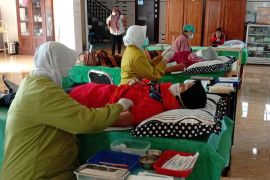“Actually, the maternal and infant mortality rates are the gauge of the nation's health status. On the other hand, (addressing) extreme poverty is an important part of achieving SDGs; what we are aiming for is that no one should go hungry," Head of BKKBN Hasto Wardoyo noted at a seminar on the results of policy studies on the stunting reduction program accessed here on Thursday.
The issue should be addressed in order to improve the quality of health of women and babies. This is because both rates would be closely related to the total birth rate (TFR).
As shown by the results of Supas in 2015, MMR in Indonesia reached 305 per 100 thousand live births. Meanwhile, IMR reached 24 per 100 thousand live births.
In SDGs, the government targets the ratio of maternal mortality to be reduced to less than 70 per 100 thousand live births as a new effort to improve the lives of mothers and babies.
It also aims to end mortality among newborns and those under five years of age by striving to reduce the neonatal mortality rate to at least 12 per one thousand live births and the under-five mortality rate to 25 per one thousand live births.
By including it in the SDGs, the government will guarantee universal access to sexual and reproductive health services, including family planning, information and education, and the integration of reproductive health into national strategies and programs.
Other aspects that should be highlighted in terms of national health were extreme poverty and birth of stunted children. According to the National Socioeconomic Survey (Susenas) in March 2021, the number of people experiencing extreme poverty in Indonesia reached 27.54 million, or 10.14 percent.
In September 2021, the number of people with extreme poverty had fallen to 26.50 million, or 9.71 percent. One must remain alert to poverty, as it could reduce the family's ability to get adequate nutritional intake, thereby resulting in children ending up with stunted growth and lack of access to proper health services.
“Stunting is part of an indicator of great quality of human resources. Hence, this is a crucial aspect that all regional heads feel. Stunting is our common enemy," he remarked.
Since 2013, the average reduction in stunting rates had never reached two percent, he said. He expected that in 2022, through the SSGI data, the trend of declining stunting rate will continue as it is currently of which in 2019, it went, from 24.4 percent from 27.7 percent.
However, these three problems could be resolved if the government also established good convergence communication, so that everyone, including families, could focus on solving these problems simultaneously in all regions.
"We are also waiting for the results of SSGI 2022, and hopefully, the rate (of stunting reduction) can be above or three percent per year according to the president's request and our aspirations. Hopefully, we will be given the ease in achieving that target," he stated.
Related news: Posyandu as spearhead for MMR, IMR reduction: Health Ministry
Related news: Total fertility rate affects maternal, infant mortality rates: BKKBN
Translator: Hreeloita D S, Mecca Yumna
Editor: Rahmad Nasution
Copyright © ANTARA 2022












